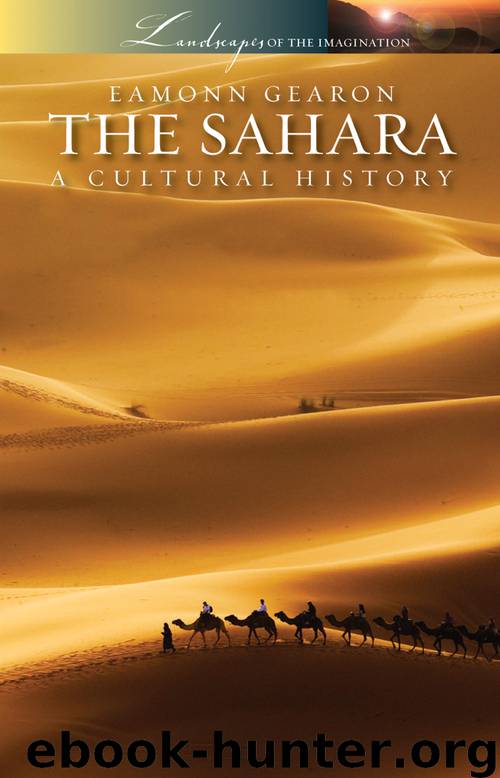The Sahara by Eamonn Gearon

Author:Eamonn Gearon
Language: eng, eng
Format: epub
Tags: Travel, Sahara, Desert, North Africa, Colonialism, Art, Culture, Literature, History, Tunisia, Berber, Tuareg
ISBN: 9781908493163
Publisher: Signal Books
Published: 2011-10-18T16:00:00+00:00
Motors, Mars and Planes
“People condemn the motor-car as unromantic. I am afraid this is natural, for no one can become fond of a thing he does not really understand, and the ordinary person understands a camel, if in concept only, because it is an animal like himself.”
Ralph Bagnold, Libyan Sands: Travels in a Dead World (1935)
From the first upright steps of homo sapiens to the birth of motor transport, the greatest speed people had experienced was on the back of a galloping horse. For most, their maximum speed was limited to however fast they could propel themselves. The development of the motorcar radically changed this. With the arrival of motorcars, large areas of the Sahara were accessible for the first time. The arrival of the car did not, however, herald the end of camels or cameleers.
Even as some said camels would become obsolete in the face of motorized transport, some of the most adventurous camel-powered desert exploration was taking place. In the winter of 1920 the Oxford-educated Egyptian diplomat and politician, two-time Olympian and grandson of the last admiral of the Egyptian fleet, Ahmed Hassanein Bey, set off for the oasis of Kufra, in the heart of the Libyan Desert. Accompanied by the English travel writer Rosita Forbes, the small band crossed the Sahara from Ajdabiya, near the Gulf of Sirte, without a car in sight.
Forbes’ account of the journey, Kufara: the Secret of the Sahara, was rightly criticized for not giving sufficient credit to Hassanein for his central role in the expedition. Yet she did dedicate the book to him, the father of Egyptian exploration: “To Ahmed Mohammed Bey Hassanein. In memory of hours grave and gay, battles desperate or humorous, of success and failure in the Libyan deserts.” Walking through the winter, the coolest and so best time for Saharan exploration, the pair and their retinue headed south towards the famously closed oasis.
Apart from its geographical isolation, the oasis had stood aloof from outsiders since becoming home to the Sanussi brotherhood in the 1890s. Hostile to all foreign occupation of the Sahara, the Sanussi clashed at various times with the French, Italians and British. Part of Forbes’ motivation for making the journey was because it was forbidden. As she says, “For a year I had worked and plotted to reach Kufara because the thought of this holy oasis, nucleus of the greatest Islamic confraternity, rigidly guarded from every stranger, the centre of the mighty influence against which every European Power has battled in turn, stirred my imagination.”
The book charts their four-month round trip of more than a thousand miles to Kufra and back via Jaghbub and Siwa, and contains all the requisite elements for a gripping yarn including fractious camels and disgruntled guides. Forbes remembers with fondness the journey’s privations and expresses a common desire to return to the magical: “Some time, somehow, I knew not where or when, but most assuredly when Allah willed, I should come back to the deserts and the strange, uncharted tracks would bear my camels south again.
Download
This site does not store any files on its server. We only index and link to content provided by other sites. Please contact the content providers to delete copyright contents if any and email us, we'll remove relevant links or contents immediately.
| Central Africa | East Africa |
| North Africa | Southern Africa |
| West Africa | Algeria |
| Egypt | Ethiopia |
| Kenya | Nigeria |
| South Africa | Sudan |
| Zimbabwe |
Goodbye Paradise(3442)
Men at Arms by Terry Pratchett(2681)
Tobruk by Peter Fitzsimons(2373)
Arabs by Eugene Rogan(2193)
Pirate Alley by Terry McKnight(2126)
Borders by unknow(2115)
Belonging by Unknown(1727)
It's Our Turn to Eat by Michela Wrong(1588)
The Biafra Story by Frederick Forsyth(1556)
Botswana--Culture Smart! by Michael Main(1482)
The Source by James A. Michener(1454)
A Winter in Arabia by Freya Stark(1444)
Gandhi by Ramachandra Guha(1426)
Coffee: From Bean to Barista by Robert W. Thurston(1419)
Livingstone by Tim Jeal(1390)
The Falls by Unknown(1369)
The Shield and The Sword by Ernle Bradford(1310)
Africa: Altered States, Ordinary Miracles by Richard Dowden(1291)
Egyptian Mythology A Fascinating Guide to Understanding the Gods, Goddesses, Monsters, and Mortals (Greek Mythology - Norse Mythology - Egyptian Mythology) by Matt Clayton(1276)
